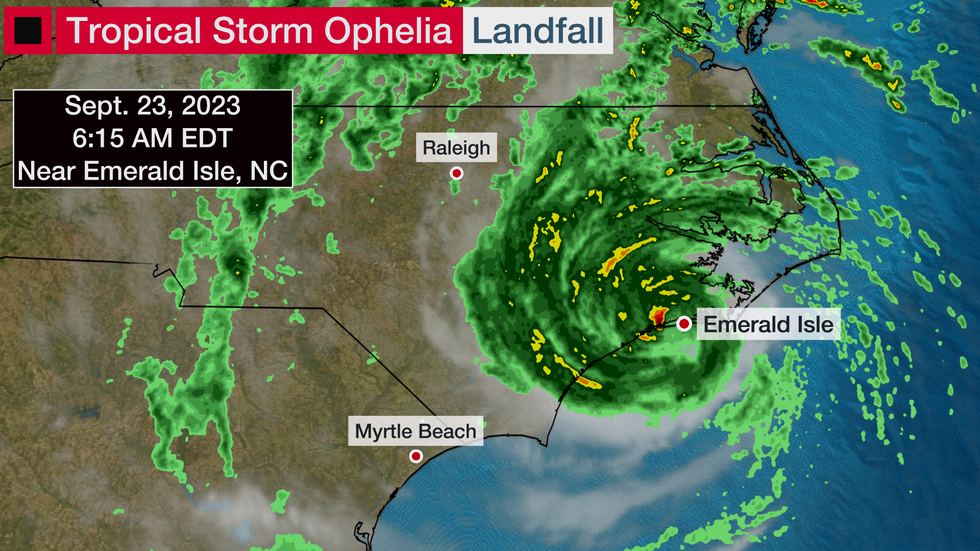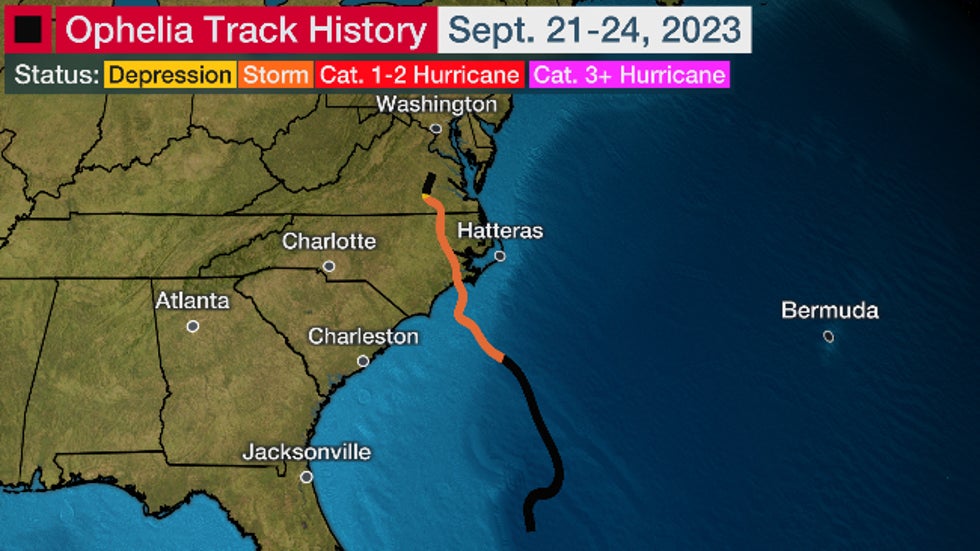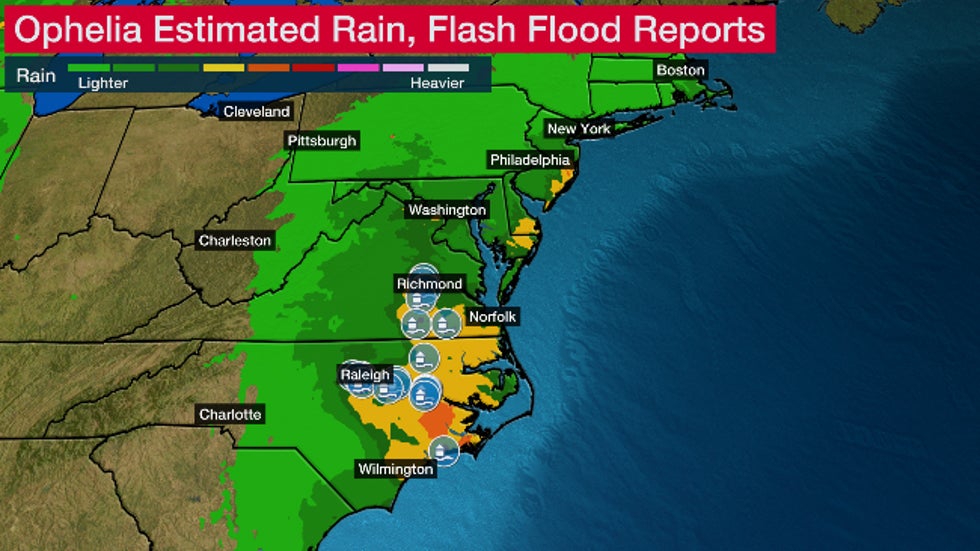Jonathan Belles and Jon Erdman
Tropical Storm Ophelia spread heavy rain, storm surge flooding, strong wind gusts and high surf along the Eastern Seaboard.
Ophelia became the 16th storm of the 2023 Atlantic hurricane season early on September 23. Ophelia developed from an area of energy and spin in the mid-levels of the atmosphere that began over the Deep South and swung southeastward across Florida and into the western Atlantic.
The system developed strong winds and increasing surf while sitting over the warm Gulf Stream current on Sept. 21, and attained winds of 40+ mph by late evening. It took on subtropical, then tropical characteristics as it neared the North Carolina coast.
Ophelia may have been a hurricane for a very short time either late on Sept. 22 or early on Sept. 23. Surface winds measured by the Hurricane Hunters temporarily briefly fluttered around 75 mph and an eye feature was briefly seen on radar and satellite data.
The storm made landfall at about 6:15 a.m. EDT on Sept. 23 near Emerald Isle, North Carolina. At landfall, Ophelia had maximum sustained winds of 70 mph, just shy of hurricane strength.

Following landfall, Ophelia quickly weakened as it moved through eastern North Carolina and eastern Virginia on September 23. Ophelia lost tropical characteristics late in the evening near Richmond, Virginia.
 The black segments of the track above correspond to when this was either "Potential Tropical Cyclone Sixteen" (south of the N.C. coast) or a "post-tropical cyclone" over Virginia.
The black segments of the track above correspond to when this was either "Potential Tropical Cyclone Sixteen" (south of the N.C. coast) or a "post-tropical cyclone" over Virginia.Impacts
Storm Surge
Storm surge battered eastern North Carolina from late on Sept. 22 through Sept. 23.
Several feet of storm surge washed over the Outer Banks of North Carolina and into much of eastern North Carolina, including New Bern. Four feet of inundation was reported on Sept. 23 along the Neuse River near Janeiro.
Docks and homes ended up in the water on the Pamlico River, in the town of Belhaven.
A storm surge of over 3.5 feet was recorded at a station at Sewell's Point, Virginia, early on Sept 23. A storm surge of 2-4 feet was common from northeastern North Carolina into the lower Chesapeake Bay.
Up to 2 feet of coastal flooding reached into the Upper Chesapeake Bay, including Annapolis and the inner harbor of Baltimore. About 2.5 feet of flooding pushed up the lower Potomac River into Alexandria, Virginia.
About 2 to 2.5 feet of inundation from flooding was also observed along the coast of Delaware and southern New Jersey at high tide.
Significant beach erosion, with water around some homes, was reported in Bowers Beach, Delaware. Numerous roads were closed due to flooding in Atlantic City, New Jersey.
Rainfall
In North Carolina, an estimated 8 to 10 inches of rain fell across Greenville and Pitt Counties, which pushed the Green Mill Run, a creek in Greenville, to its highest level in four years, according to the National Weather Service. Flooding closed numerous roads and required water rescues in the city of Greenville, including areas near East Carolina University.

Flash flooding also was reported at two intersections in Richmond, Virginia.
Here are some other notable rainfall totals by state:
- 8.82 inches in Jacksonville, North Carolina
- 5.63 inches in Hartfield, Virginia
- 5.23 inches near Toms River, New Jersey
- 3.98 inches near Huntingtown, Maryland
- 3.80 inches near Millsboro, Delaware
- 3.58 inches near Myrtle Beach, South Carolina
- 2.78 inches near Carlisle, Pennsylvania
Winds
A buoy about 30 miles offshore of Wrightsville Beach, North Carolina, reported a wind gust of 83 mph.
Strong winds tore parts of a roof off of a condo building near Ocean City, Maryland.
Scattered trees and power lines were downed, some on homes and vehicles, from North Carolina to Maryland. Tens of thousands were without power from Ophelia.
Gusty conditions and increased surf reached as far north as New Jersey and Long Island. In Delaware, wind gusts were occasionally over 30 mph as bands of rain moved through. In New Jersey, waves are occasionally topped the seawall in Wildwood.
Here are some of the peak rain and wind gusts by state:
- 72 mph: Cape Lookout, North Carolina
- 64 mph: Lewes, Delaware
- 63 mph: Chesapeake Light Tower in Virginia
- 62 mph: North Beach Haven, New Jersey
- 56 mph: Cape St. Claire, Maryland
- 44 mph: Myrtle Beach, South Carolina
The Weather Company’s primary journalistic mission is to report on breaking weather news, the environment and the importance of science to our lives. This story does not necessarily represent the position of our parent company, IBM.
The Weather Company’s primary journalistic mission is to report on breaking weather news, the environment and the importance of science to our lives. This story does not necessarily represent the position of our parent company, IBM.

No comments:
Post a Comment